TOYOTA RAV4 2022 Owners Manual
Manufacturer: TOYOTA, Model Year: 2022, Model line: RAV4, Model: TOYOTA RAV4 2022Pages: 748, PDF Size: 22.93 MB
Page 221 of 748
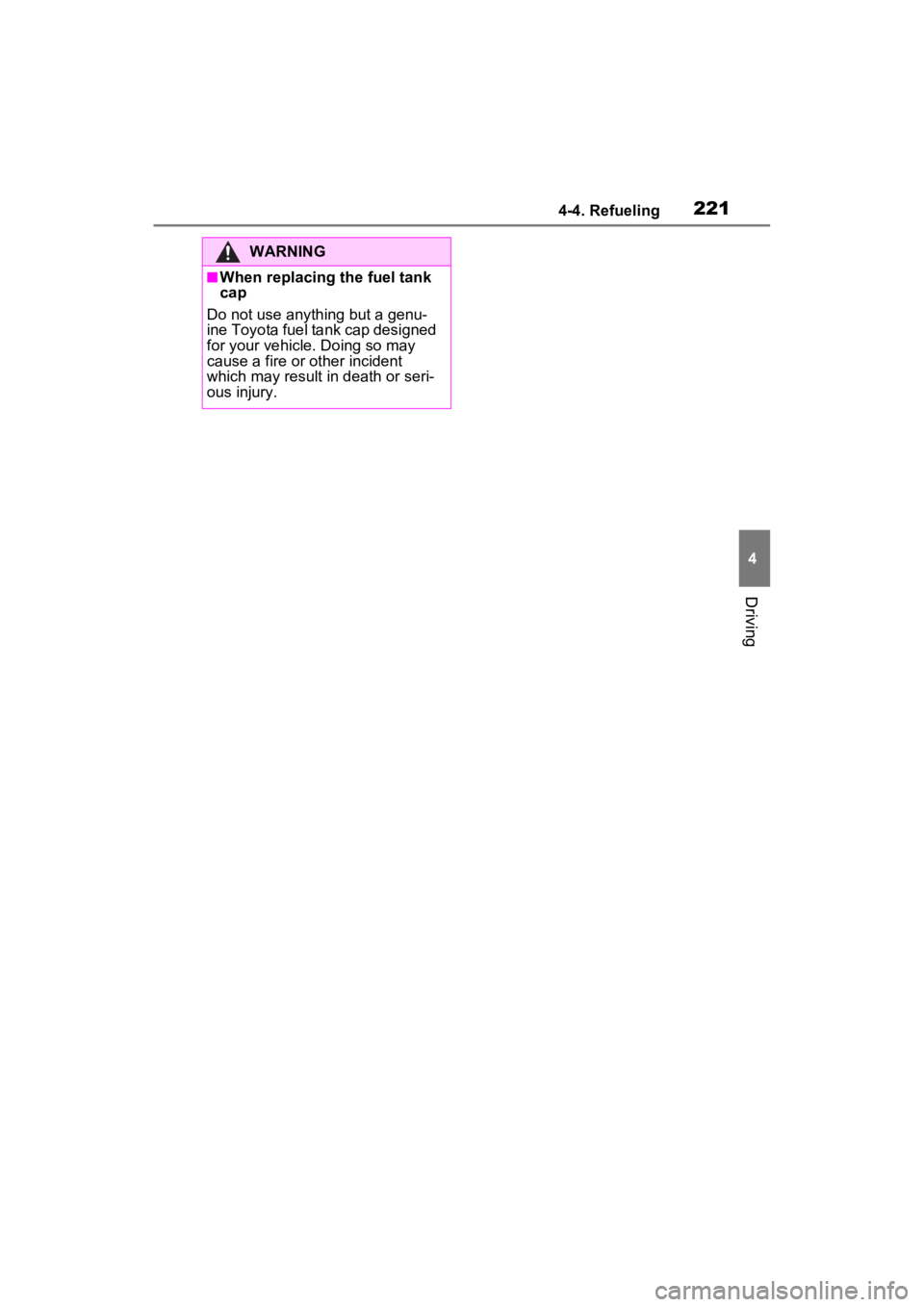
2214-4. Refueling
4
Driving
WARNING
‚Ė†When replacing the fuel tank
cap
Do not use anything but a genu-
ine Toyota fuel tank cap designed
for your vehicle. Doing so may
cause a fire or other incident
which may result in death or seri-
ous injury.
Page 222 of 748
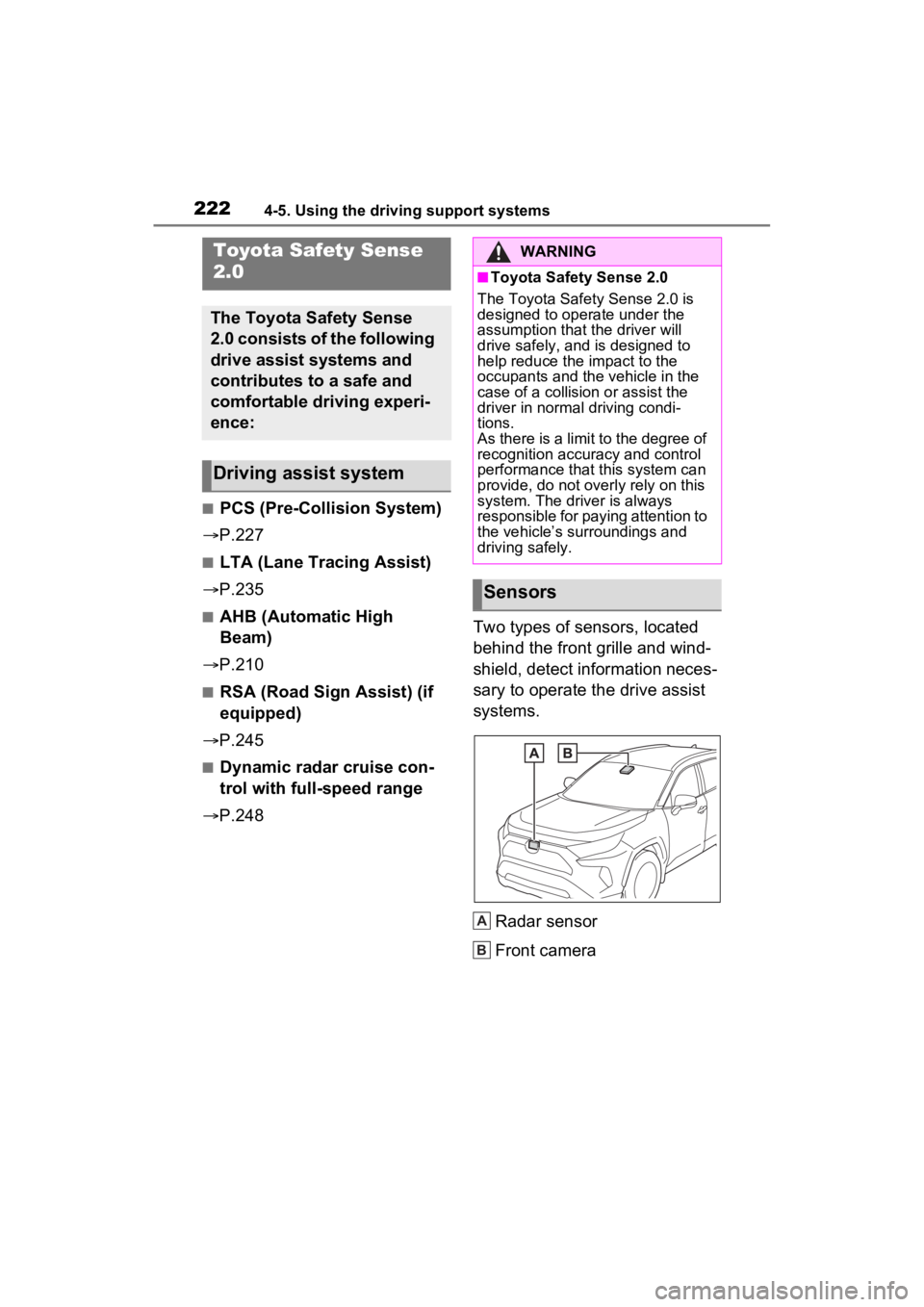
2224-5. Using the driving support systems
4-5.Using the driving support systems
‚Ė†PCS (Pre-Collision System)
Ôāģ P.227
‚Ė†LTA (Lane Tracing Assist)
Ôāģ P.235
‚Ė†AHB (Automatic High
Beam)
Ôāģ P.210
‚Ė†RSA (Road Sign Assist) (if
equipped)
Ôāģ P.245
‚Ė†Dynamic radar cruise con-
trol with full-speed range
Ôāģ P.248 Two types of sensors, located
behind the front grille and wind-
shield, detect information neces-
sary to operate the drive assist
systems.
Radar sensor
Front camera
Toyota Safety Sense
2.0
The Toyota Safety Sense
2.0 consists of the following
drive assist systems and
contributes to a safe and
comfortable driving experi-
ence:
Driving assist system
WARNING
‚Ė†Toyota Safety Sense 2.0
The Toyota Safety Sense 2.0 is
designed to operate under the
assumption that the driver will
drive safely, and is designed to
help reduce the impact to the
occupants and the vehicle in the
case of a collision or assist the
driver in normal driving condi-
tions.
As there is a limit to the degree of
recognition accuracy and control
performance that this system can
provide, do not overly rely on this
system. The driver is always
responsible for paying attention to
the vehicle’s su rroundings and
driving safely.
Sensors
A
B
Page 223 of 748
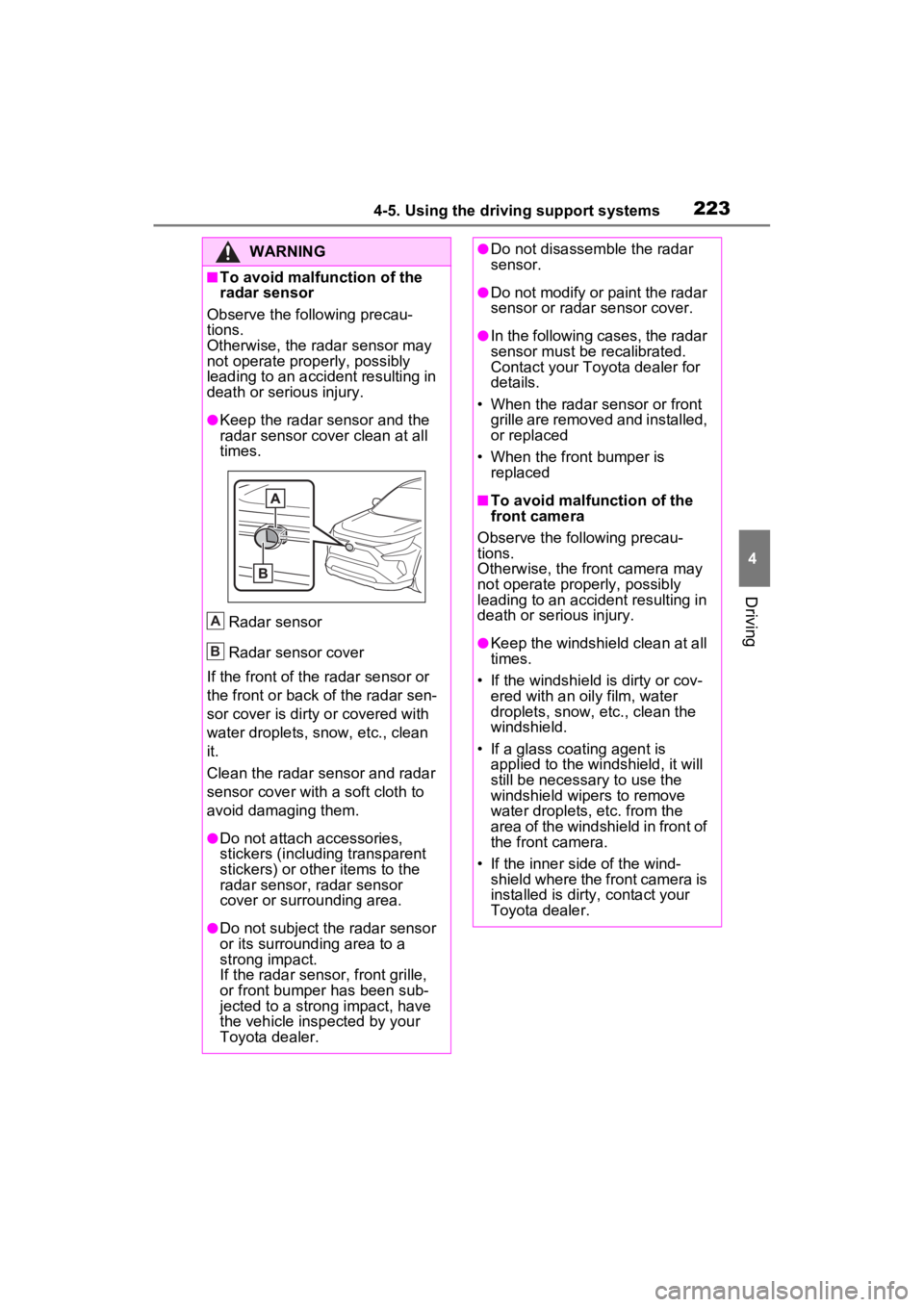
2234-5. Using the driving support systems
4
Driving
WARNING
‚Ė†To avoid malfunction of the
radar sensor
Observe the following precau-
tions.
Otherwise, the radar sensor may
not operate properly, possibly
leading to an accident resulting in
death or serious injury.
‚óŹKeep the radar sensor and the
radar sensor cover clean at all
times.
Radar sensor
Radar sensor cover
If the front of the r adar sensor or
the front or back of the radar sen-
sor cover is dirty or covered with
water droplets, snow, etc., clean
it.
Clean the radar sensor and radar
sensor cover with a soft cloth to
avoid damaging them.
‚óŹDo not attach accessories,
stickers (including transparent
stickers) or other items to the
radar sensor, radar sensor
cover or surrounding area.
‚óŹDo not subject the radar sensor
or its surrounding area to a
strong impact.
If the radar sensor, fron t grille,
or front bumper has been sub-
jected to a strong impact, have
the vehicle insp ected by your
Toyota dealer.
A
B
‚óŹDo not disassemble the radar
sensor.
‚óŹDo not modify or paint the radar
sensor or radar sensor cover.
‚óŹIn the following cases, the radar
sensor must be recalibrated.
Contact your Toyota dealer for
details.
‚ÄĘ When the radar s ensor or front
grille are removed and installed,
or replaced
‚ÄĘ When the front bumper is replaced
‚Ė†To avoid malfunction of the
front camera
Observe the following precau-
tions.
Otherwise, the f ront camera may
not operate properly, possibly
leading to an accident resulting in
death or serious injury.
‚óŹKeep the windshield clean at all
times.
‚ÄĘ If the windshield is dirty or cov-
ered with an o ily film, water
droplets, snow, etc., clean the
windshield.
‚ÄĘ If a glass coating agent is applied to the windshield, it will
still be necessary to use the
windshield wipers to remove
water droplets, etc. from the
area of the windshield in front of
the front camera.
‚ÄĘ If the inner side of the wind- shield where the front camera is
installed is dirty, contact your
Toyota dealer.
Page 224 of 748
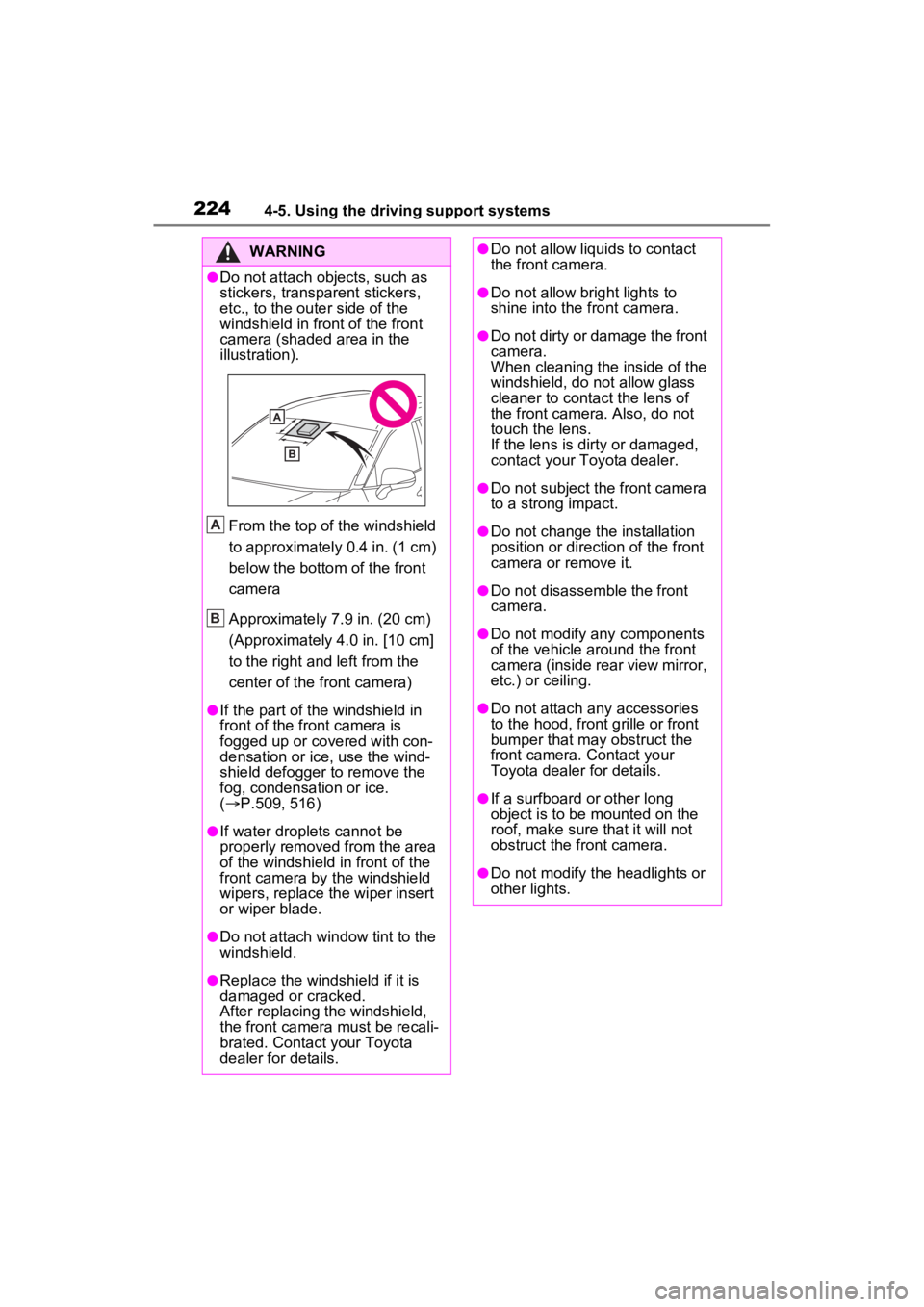
2244-5. Using the driving support systems
WARNING
‚óŹDo not attach objects, such as
stickers, transparent stickers,
etc., to the outer side of the
windshield in fr ont of the front
camera (shaded area in the
illustration).
From the top of the windshield
to approximately 0.4 in. (1 cm)
below the bottom of the front
camera
Approximately 7.9 in. (20 cm)
(Approximately 4.0 in. [10 cm]
to the right and left from the
center of the front camera)
‚óŹIf the part of the windshield in
front of the front camera is
fogged up or covered with con-
densation or ice, use the wind-
shield defogger to remove the
fog, condensation or ice.
(Ôāģ P.509, 516)
‚óŹIf water droplets cannot be
properly removed from the area
of the windshield in front of the
front camera by the windshield
wipers, replace the wiper insert
or wiper blade.
‚óŹDo not attach win dow tint to the
windshield.
‚óŹReplace the windshield if it is
damaged or cracked.
After replacing the windshield,
the front camera must be recali-
brated. Contact your Toyota
dealer for details.
A
B
‚óŹDo not allow liquids to contact
the front camera.
‚óŹDo not allow bright lights to
shine into the front camera.
‚óŹDo not dirty or damage the front
camera.
When cleaning the inside of the
windshield, do not allow glass
cleaner to contact the lens of
the front camera . Also, do not
touch the lens.
If the lens is dirty or damaged,
contact your Toyota dealer.
‚óŹDo not subject the front camera
to a strong impact.
‚óŹDo not change the installation
position or direction of the front
camera or remove it.
‚óŹDo not disassemble the front
camera.
‚óŹDo not modify any components
of the vehicle around the front
camera (inside rear view mirror,
etc.) or ceiling.
‚óŹDo not attach any accessories
to the hood, front grille or front
bumper that may obstruct the
front camera. Contact your
Toyota dealer for details.
‚óŹIf a surfboard or other long
object is to be mounted on the
roof, make sure that it will not
obstruct the front camera.
‚óŹDo not modify the headlights or
other lights.
Page 225 of 748
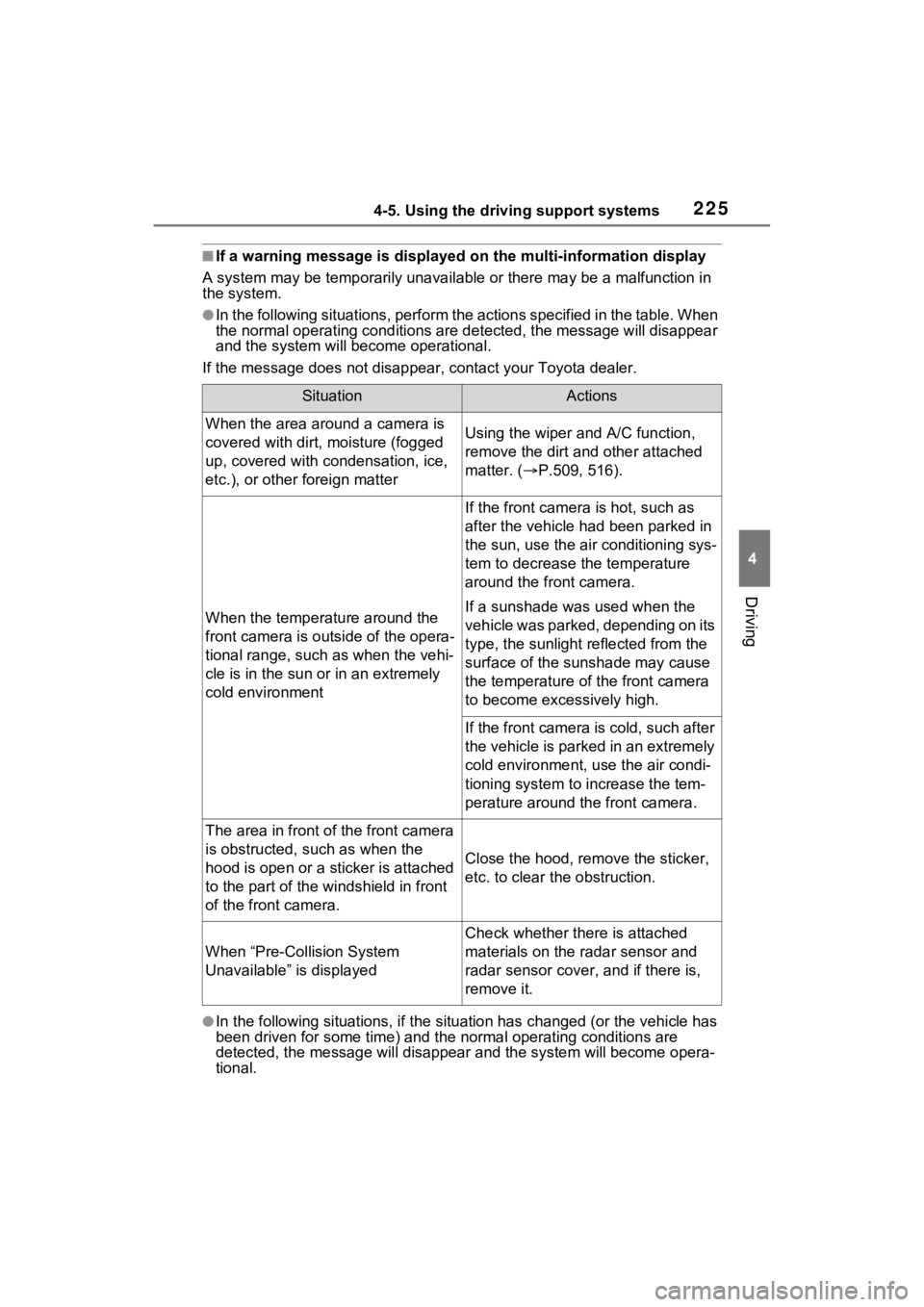
2254-5. Using the driving support systems
4
Driving
‚Ė†If a warning message is displayed on the multi-information display
A system may be temporarily unava ilable or there may be a malfunction in
the system.
‚óŹIn the following situations, perform the actions specified in t he table. When
the normal operating conditions are detected, the message will disappear
and the system will be come operational.
If the message does not disapp ear, contact your Toyota dealer.
‚óŹIn the following situations, if the situation has changed (or the vehicle has
been driven for some time) and the normal operating conditions are
detected, the message will disappear and the system will become opera-
tional.
SituationActions
When the area around a camera is
covered with dirt, moisture (fogged
up, covered with condensation, ice,
etc.), or other foreign matterUsing the wiper and A/C function,
remove the dirt and other attached
matter. ( ÔāģP.509, 516).
When the temperature around the
front camera is outside of the opera-
tional range, such as when the vehi-
cle is in the sun or in an extremely
cold environment
If the front camera is hot, such as
after the vehicle had been parked in
the sun, use the air conditioning sys-
tem to decrease the temperature
around the front camera.
If a sunshade was used when the
vehicle was parked, depending on its
type, the sunlight reflected from the
surface of the sunshade may cause
the temperature of the front camera
to become excessively high.
If the front camera is cold, such after
the vehicle is parked in an extremely
cold environment, use the air condi-
tioning system to increase the tem-
perature around the front camera.
The area in front o f the front camera
is obstructed, such as when the
hood is open or a sticker is attached
to the part of the win dshield in front
of the front camera.
Close the hood, rem ove the sticker,
etc. to clear the obstruction.
When “Pre-Collision System
Unavailable‚ÄĚ is displayed
Check whether there is attached
materials on the radar sensor and
radar sensor cover , and if there is,
remove it.
Page 226 of 748

2264-5. Using the driving support systems
If the message does not disappear, contact your Toyota dealer.
‚ÄĘ When the temperature around the radar sensor is outside of the opera-
tional range, such as when the vehicle is in the sun or in an e xtremely cold
environment
‚ÄĘ When the front camera cannot d etect objects in front of the vehicle, such
as when driving in the dark, sno w, or fog, or when bright lights are shining
into the front camera
‚ÄĘ Depending on the conditions in the vicinity of the vehicle, th e radar may
judge the surrounding environment can not be properly recognize d. In that
case, ‚ÄúPre-Collision System Unavailable‚ÄĚ is displayed.
Page 227 of 748
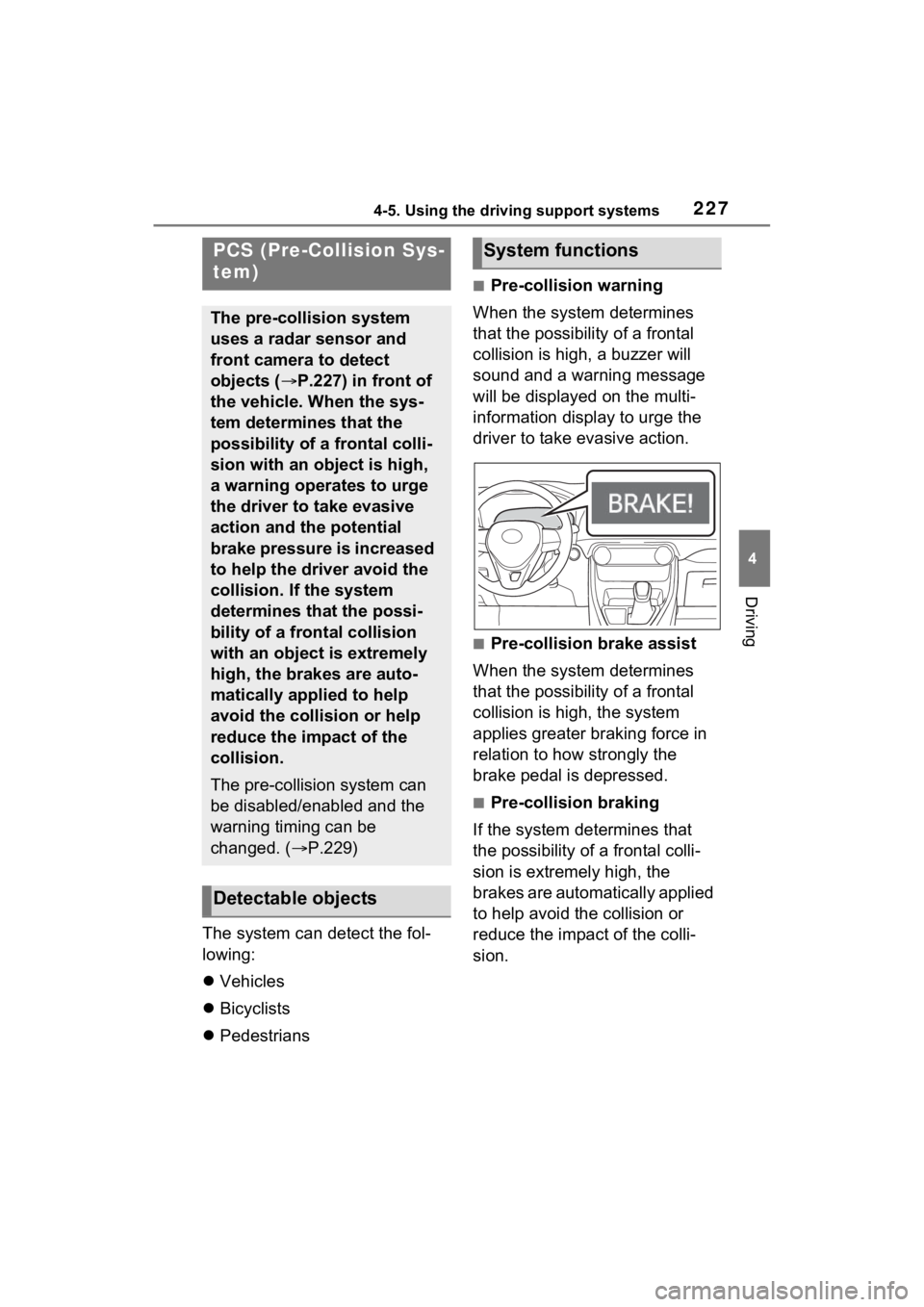
2274-5. Using the driving support systems
4
Driving
The system can detect the fol-
lowing:
ÔĀ¨Vehicles
ÔĀ¨ Bicyclists
ÔĀ¨ Pedestrians
‚Ė†Pre-collision warning
When the system determines
that the possibility of a frontal
collision is high, a buzzer will
sound and a warning message
will be displayed on the multi-
information display to urge the
driver to take evasive action.
‚Ė†Pre-collision brake assist
When the system determines
that the possibility of a frontal
collision is high, the system
applies greater braking force in
relation to how strongly the
brake pedal is depressed.
‚Ė†Pre-collision braking
If the system determines that
the possibility of a frontal colli-
sion is extremely high, the
brakes are automatically applied
to help avoid the collision or
reduce the impact of the colli-
sion.
PCS (Pre-Collision Sys-
tem)
The pre-collision system
uses a radar sensor and
front camera to detect
objects ( ÔāģP.227) in front of
the vehicle. When the sys-
tem determines that the
possibility of a frontal colli-
sion with an object is high,
a warning operates to urge
the driver to take evasive
action and the potential
brake pressure is increased
to help the driver avoid the
collision. If the system
determines that the possi-
bility of a frontal collision
with an object is extremely
high, the brakes are auto-
matically applied to help
avoid the collision or help
reduce the impact of the
collision.
The pre-collision system can
be disabled/enabled and the
warning timing can be
changed. ( ÔāģP.229)
Detectable objects
System functions
Page 228 of 748
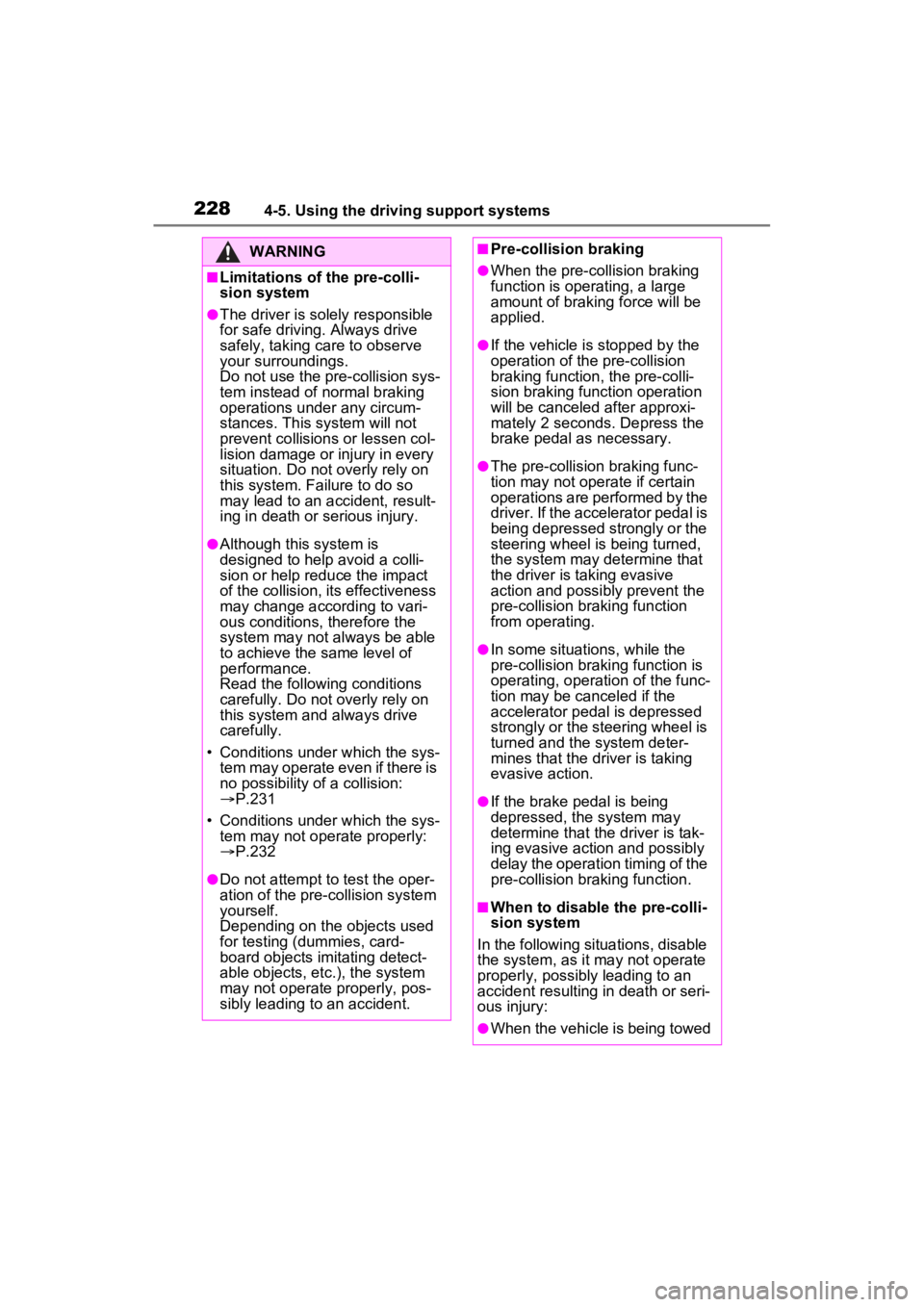
2284-5. Using the driving support systems
WARNING
‚Ė†Limitations of the pre-colli-
sion system
‚óŹThe driver is solely responsible
for safe driving. Always drive
safely, taking care to observe
your surroundings.
Do not use the pre-collision sys-
tem instead of normal braking
operations under any circum-
stances. This system will not
prevent collisions or lessen col-
lision damage or injury in every
situation. Do not overly rely on
this system. Failure to do so
may lead to an accident, result-
ing in death or serious injury.
‚óŹAlthough this system is
designed to help avoid a colli-
sion or help reduce the impact
of the collision, its effectiveness
may change according to vari-
ous conditions, therefore the
system may not always be able
to achieve the same level of
performance.
Read the following conditions
carefully. Do not overly rely on
this system and always drive
carefully.
‚ÄĘ Conditions under which the sys- tem may operate even if there is
no possibility of a collision:
Ôāģ P.231
‚ÄĘ Conditions under which the sys- tem may not operate properly:
Ôāģ P.232
‚óŹDo not attempt to test the oper-
ation of the pre-collision system
yourself.
Depending on the objects used
for testing (dummies, card-
board objects imitating detect-
able objects, etc.), the system
may not operate properly, pos-
sibly leading to an accident.
‚Ė†Pre-collision braking
‚óŹWhen the pre-collision braking
function is operating, a large
amount of braking force will be
applied.
‚óŹIf the vehicle is stopped by the
operation of the pre-collision
braking function, the pre-colli-
sion braking function operation
will be canceled after approxi-
mately 2 seconds. Depress the
brake pedal as necessary.
‚óŹThe pre-collision braking func-
tion may not operate if certain
operations are performed by the
driver. If the accelerator pedal is
being depressed strongly or the
steering wheel is being turned,
the system may determine that
the driver is taking evasive
action and possibly prevent the
pre-collision braking function
from operating.
‚óŹIn some situations, while the
pre-collision brak ing function is
operating, operation of the func-
tion may be canceled if the
accelerator pedal is depressed
strongly or the steering wheel is
turned and the system deter-
mines that the driver is taking
evasive action.
‚óŹIf the brake pedal is being
depressed, the system may
determine that t he driver is tak-
ing evasive action and possibly
delay the operation timing of the
pre-collision braking function.
‚Ė†When to disable the pre-colli-
sion system
In the following situations, disable
the system, as it may not operate
properly, possibly leading to an
accident resulting in death or seri-
ous injury:
‚óŹWhen the vehicle is being towed
Page 229 of 748
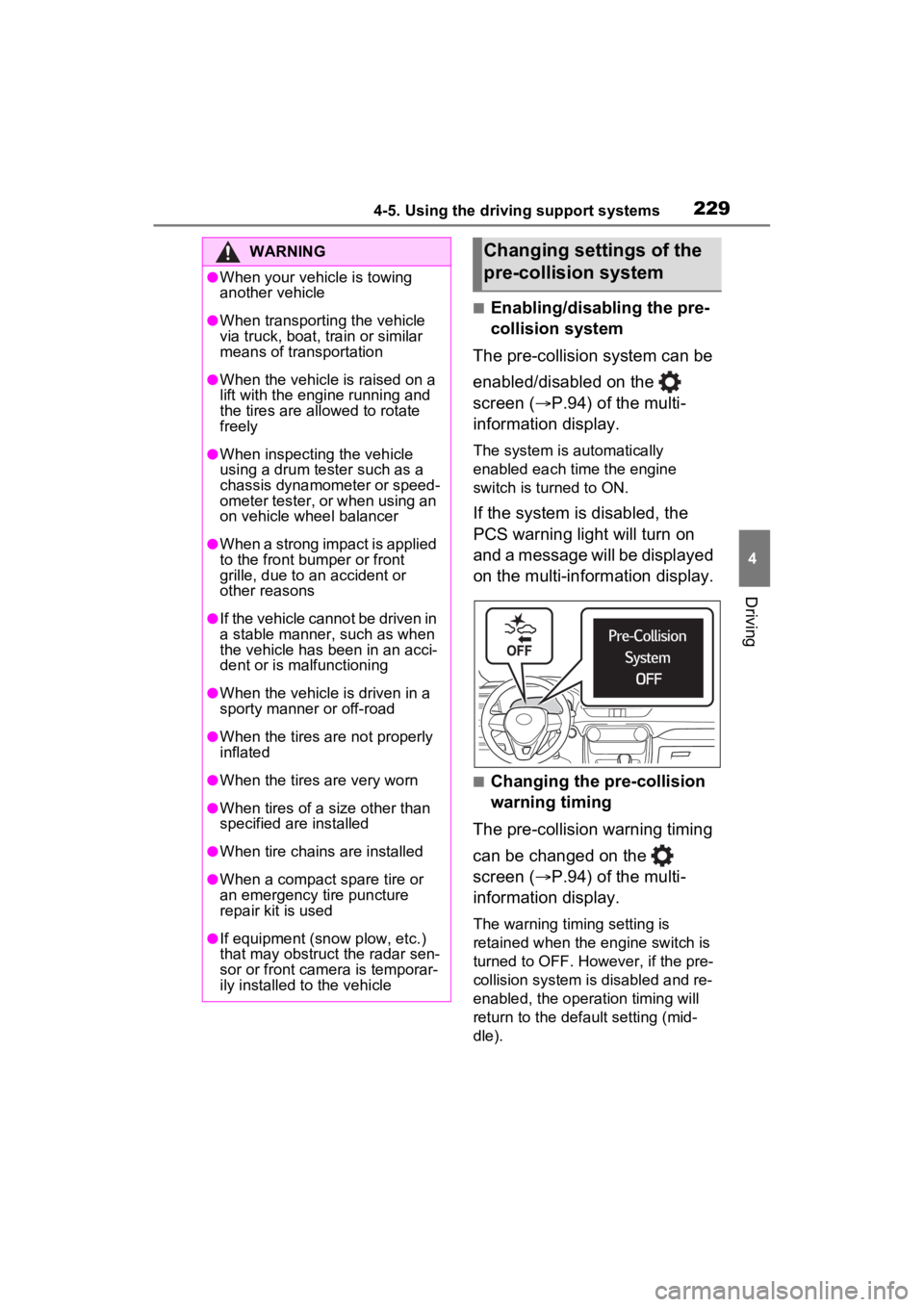
2294-5. Using the driving support systems
4
Driving
‚Ė†Enabling/disabling the pre-
collision system
The pre-collision system can be
enabled/disabled on the
screen ( ÔāģP.94) of the multi-
information display.
The system is automatically
enabled each time the engine
switch is turned to ON.
If the system is disabled, the
PCS warning light will turn on
and a message will be displayed
on the multi-information display.
‚Ė†Changing the pre-collision
warning timing
The pre-collision warning timing
can be changed on the
screen ( ÔāģP.94) of the multi-
information display.
The warning timing setting is
retained when the engine switch is
turned to OFF. However, if the pre-
collision system is disabled and re-
enabled, the operation timing will
return to the default setting (mid-
dle).
WARNING
‚óŹWhen your vehicle is towing
another vehicle
‚óŹWhen transporting the vehicle
via truck, boat, train or similar
means of transportation
‚óŹWhen the vehicle is raised on a
lift with the engine running and
the tires are allowed to rotate
freely
‚óŹWhen inspecting the vehicle
using a drum tester such as a
chassis dynamometer or speed-
ometer tester, or when using an
on vehicle wheel balancer
‚óŹWhen a strong impact is applied
to the front bumper or front
grille, due to a n accident or
other reasons
‚óŹIf the vehicle cannot be driven in
a stable manner, such as when
the vehicle has been in an acci-
dent or is malfunctioning
‚óŹWhen the vehicle is driven in a
sporty manner or off-road
‚óŹWhen the tires are not properly
inflated
‚óŹWhen the tires are very worn
‚óŹWhen tires of a size other than
specified are installed
‚óŹWhen tire chains are installed
‚óŹWhen a compact spare tire or
an emergency tire puncture
repair kit is used
‚óŹIf equipment (snow plow, etc.)
that may obstruct the radar sen-
sor or front camera is temporar-
ily installed to the vehicle
Changing settings of the
pre-collision system
Page 230 of 748
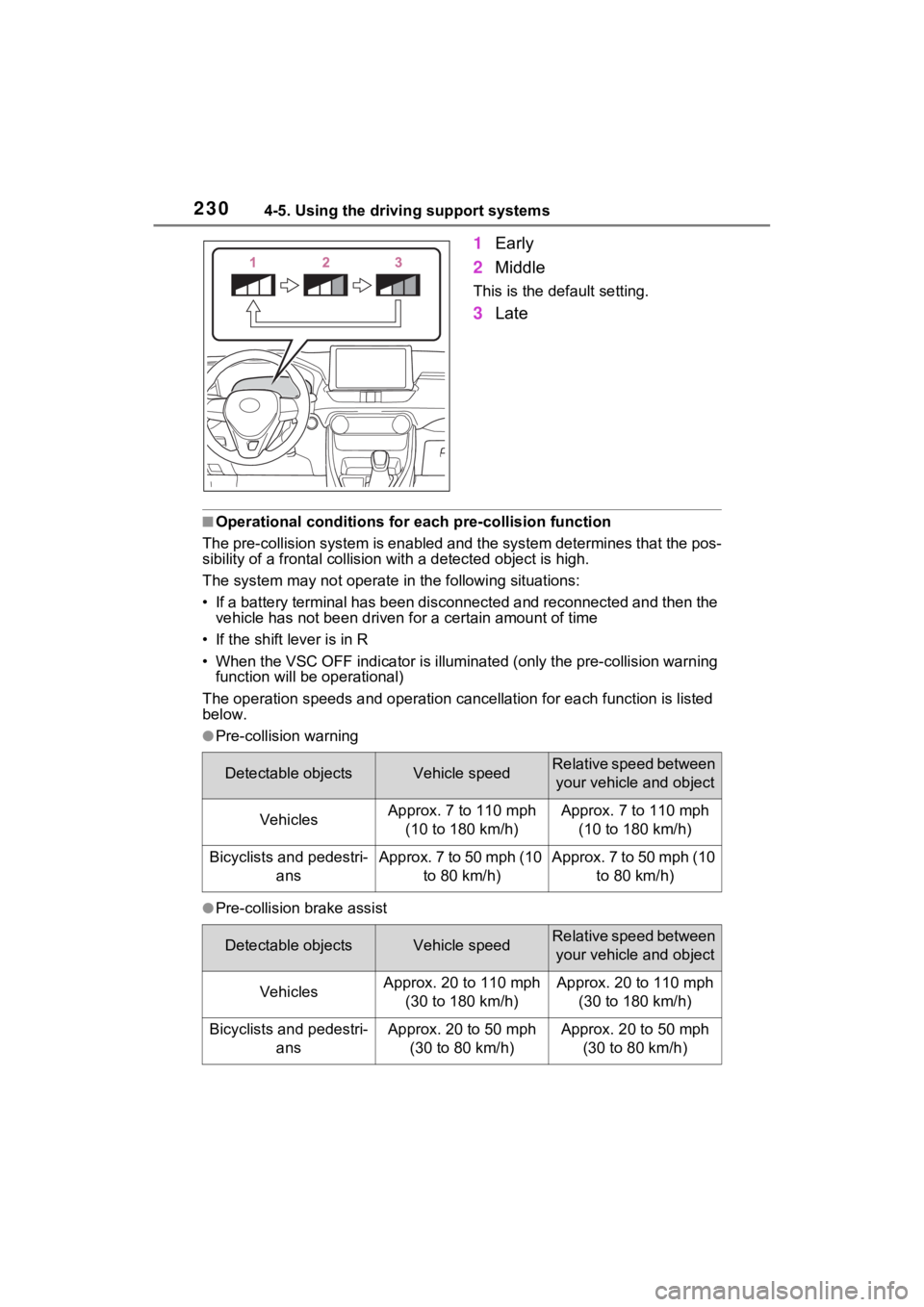
2304-5. Using the driving support systems
1Early
2 Middle
This is the default setting.
3Late
‚Ė†Operational conditions for e ach pre-collision function
The pre-collision syst em is enabled and the system determines t hat the pos-
sibility of a frontal c ollision with a detected object is high.
The system may not operate in the following situations:
‚ÄĘ If a battery terminal has been disconnected and reconnected an d then the
vehicle has not been driven for a certain amount of time
‚ÄĘ If the shift lever is in R
‚ÄĘ When the VSC OFF indicator is illuminated (only the pre-collision warning
function will be operational)
The operation speeds and operati on cancellation for each function is listed
below.
‚óŹPre-collision warning
‚óŹPre-collision brake assist
Detectable objectsVehicle speedRelative speed between
your vehicle and object
VehiclesApprox. 7 to 110 mph (10 to 180 km/h)Approx. 7 to 110 mph (10 to 180 km/h)
Bicyclists and pedestri- ansApprox. 7 to 50 mph (10 to 80 km/h)Approx. 7 to 50 mph (10 to 80 km/h)
Detectable objectsVehicle speedRelative speed between your vehicle and object
VehiclesApprox. 20 to 110 mph (30 to 180 km/h)Approx. 20 to 110 mph (30 to 180 km/h)
Bicyclists and pedestri- ansApprox. 20 to 50 mph (30 to 80 km/h)Approx. 20 to 50 mph (30 to 80 km/h)